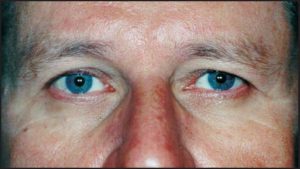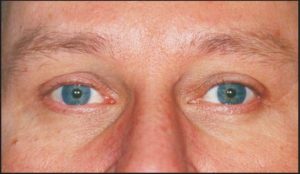The Brow Lift
Introduction
As one ages, the upper and lower lid skin stretches, muscles weaken and fat pockets bulge. The skin and subcutaneous tissue of the forehead also relax causing a downward migration of the eyebrows.
Upper-eyelid skin redundancy is a product of both eyebrow descent and the development of excess eyelid skin. Although drooping brows occur most commonly along the outer portions of the eyebrow (temporal brow), a droop of the inner brow, or the entire brow can also occur. Drooping brows may feel like a weight on the eyelid and may contribute to a shadow above the eyelids. As the eyebrows fall, there is a tendency to use the forehead muscle (frontalis muscle) to hold them up. This causes the gradual formation of horizontal lines across the forehead. These lines convey an older appearance and take away from ones overall attractiveness. Continuous use of the frontalis muscle often creates a headache by the end of the day. Frowning, which also occurs throughout the day whether we like it or not, causes further descent of the brows as well as formation of vertical lines between brows. With time these lines develop into folds and are quite noticeable in some people. Vertical lines between the brows convey worry, concern and anger.
Having the eyebrows raised to their normal level is referred to as a “brow lift”. A brow lift can restore a younger, more rested appearance as well as removing any visual field restriction.
When should brow elevation be considered?
Eyebrow position requires assessment in ever y patient considering upper blepharoplasty. Most patients are unaware of the role their eyebrow plays in contributing to eyelid skin redundancy.
Male brows on average are wider, thicker and more full in appearance than a female brow. Male brows are generally parallel to the boney orbital rim or slightly lower (common). Female brows for the most part are higher in position than a male brow, and lay parallel to or above the level of the boney rim. When a female brow falls below the orbital rim and a man’s well below the rim, a brow elevation should be considered.
If brow elevation is required but only the eyelid skin is removed, the brows may be pulled further downward. In addition, many patients with low brows use their forehead muscles to keep the brow up. Once the eyelid skin is removed the forehead muscles relax allowing the brows to fall. Some patients may complain following upper blepharoplasty surgery that there is little improvement following eyelid surgery. What has happened is the forehead muscles have relaxed allowing the eyebrows to move downward. As the eyebrows move downward the heavy eyelid appearance reappears and the patient sees little change.

52 year old female with drooping brows pre-op.

48 year old man with drooping brows pre-op.

3 months post endoscopic brow elevation and upper blepharoplasty.

3 months post endoscopic brow elevation.
Post-operative effects
Some degree of bruising and swelling are normal after brow surgery. This generally lasts one to two weeks and then subsides. Mild to moderate pain, is common for 1-2 days after surgery but can be controlled with medication. Significant pain is very rare and should be brought to the surgeon’s attention. A numb feeling on the forehead or top of the head is normal. This resolves over several weeks post-operatively. Dressings are removed the following day. If the endoscopic lift was done, staples and screws are removed in 7-10 days.
How are the brows raised?
There are several techniques to raise the eyebrows. An injection of botulinum toxin (Botox®) just below the lateral brow and just above the medial brow will raise the eyebrow 1-3 millimeters in some individuals. There are also several surgical techniques to raise the brows. Brow elevation can be carried out by an endoscopic approach, a temporal hairline incision, or through a prominent forehead line.
The Endoscopic Forehead lift
This form of lift is used to elevate the eyebrows, smooth the forehead and decrease the vertical lines between the eyebrows. It can be combined with other eyelid surgery (blepharoplasty, ptosis surgery) or face lifting procedures. Five small incisions (10-12 mm) are made just behind the hairline. Through these sites an endoscope is used to dissect the forehead and brow tissue away from the bone. The brow depressor muscles are weakened and in some cases partially removed during the procedure. The eyebrows and forehead tissue are then lifted superiorly and held in place by three small screws that are in position for 10 days. Surgical staples are used to close the scalp incisions. The procedure takes one to two hours and may be done under local or general anesthesia.
The Temporal Hairline Brow lift
This form of brow lift raises the temporal brow only, the rest of the brow is untouched. The incision is at the junction of the hairline and scalp. The technique is best suited to those individuals with a mild to moderate temporal brow droop who wear their hair down in the temple area. The procedure takes approximately 45 minutes to do and is usually done under local anesthesia.
The Direct Brow Lift
A direct brow lift is done through a prominent forehead line or immediately adjacent to the brow hair. It will allow a mild degree of temporal brow elevation. It is most useful in those patients with prominent horizontal forehead lines or full eyebrows, which will hide the brow incision. The procedure takes approximately 30 minutes to do and is preformed under local anesthesia.
Complications
The risks of endoscopic forehead lift surgery and other brow surgeries are infrequent and usually minor. There is however, a great variability in individuals healing abilities and reaction to surgery. The most common problem after endoscopic brow surgery is temporary numbness of the forehead skin and top of the head area. This resolves over the first few weeks but may occasionally last several months. Occasionally a small build up of blood under the forehead skin develops (hematoma) which resolves with time and warm compresses.
With a direct forehead lift, one of the subcutaneous sutures may cause a sharp shooting pain in the forehead due to pinching of a sensory nerve. If this occurs, the stitch may have to be cut and removed four to six weeks post-op.
Will OHIP cover the eyebrow surgery?
Ohip does not cover brow elevation surgery, even though the brows may be contributing to a significant visual field restriction. If a facial nerve palsy (Bell’s Palsy) is present they may cover elevation of the eyebrow on the affected side.
Summary
With age, the upper and lower eyelids become “droopy” or “baggy” in appearance, making one look “more tired” and “older” than they really are. Drooping eyebrows also contribute to these effects and in some patients are responsible for most of the “aged” or “tired appearance”. Brow lifting surgery provides both functional and cosmetic improvement with minimal risk of serious problems.







